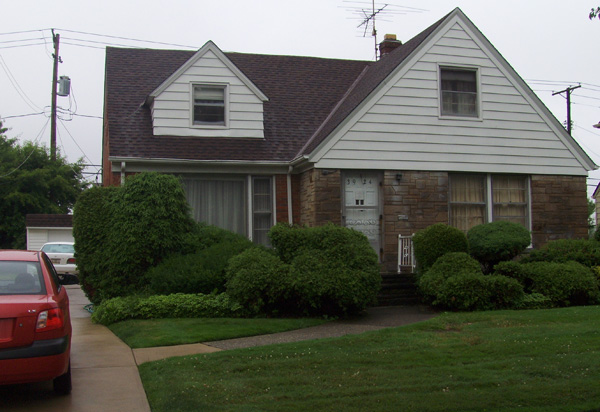
Jack Saul’s Cleveland home
After Jack Saul died in May 2009, Nathan Tinanoff of the Judaica Sound Archives was called to the Sauls’ home in Cleveland. The Saul family wanted to donate the Judaica portion of Jack’s huge collection of sound recordings to the JSA. Although Nat had spoken with Jack Saul several times over the years and had been told by many people of his incredible collection of recordings, he was still unprepared for what he found. The small suburban bungalow was unremarkable. But what was inside was remarkable indeed!
What Nat saw were stacks of records! Stacks of records in the living room. Stacks of records in the basement. Stacks of records on the stairs. Stacks of records on the dining room table. The house was literally jam-packed with phonograph recordings, tapes, and CDs.
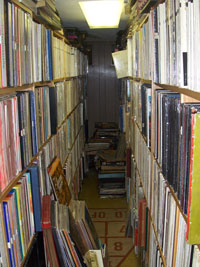
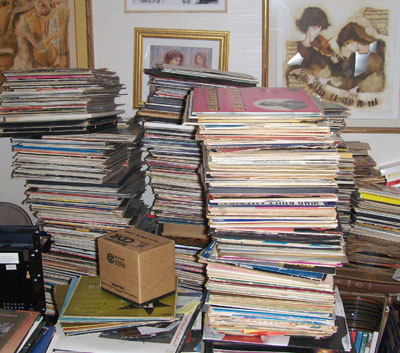
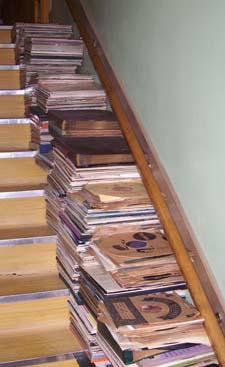
Jack Saul’s staircase
The first task that Nat faced was to locate the Judaica recordings. He was able to identify over 12,000 recordings that could be added to the archives. But there were other treasures that he discovered. For example, he found tens of thousands of 78 rpm phonograph recordings that were in mint condition. Even though they weren’t Judaica, he knew they were important.
When Nat returned to Florida he and Dr. William Miller (Dean of FAU Libraries) had a talk. Dr. Miller agreed that the collection of 78 rpm recordings were just too rare and valuable to be left behind. Dr. Miller decided to bring those records to FAU Libraries to start a new collection of vintage phonograph recordings at the Wimberly Library.
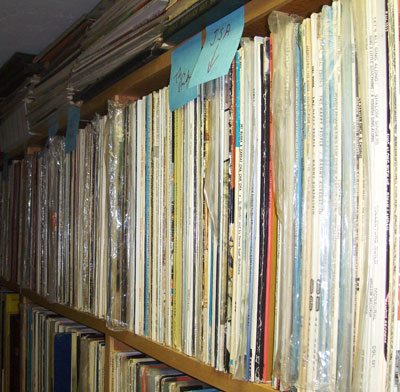
LP albums headed for JSA in Boca Raton, FL
We were delighted when Jack Saul visited the Judaica Sound Archives in February 2009. He was accompanied by his wife, Hinda, his son Ken and daughter-in-law Julie. Jack was well-known to us because he had amassed what we believed to be the largest private collection of sound recordings in the USA, maybe in the world.
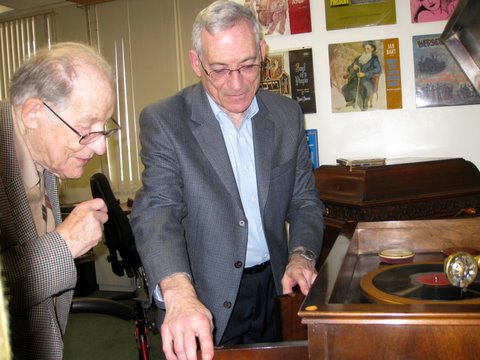
Jack Saul and Nathan Tinanoff examine an old Victrola at the JSA in February 2009
Jack Saul and his family were impressed by what they saw at the JSA. As he walked down the aisles of shelves holding tapes, CDs and LP phonograph albums Saul would stop from time to time to comment about a recording. He was very knowledgeable and seemed to know every one of his tens of thousands of recordings personally.
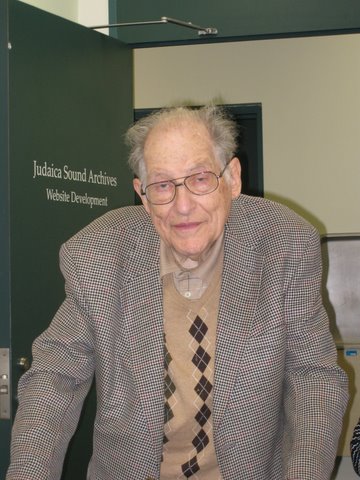
Jack Saul visits JSA 2-6-09
According to Arlene Fine of the Cleveland Jewish News Jack Saul filled his modest home with over 150,000 phonograph records. Over 36,000 of these have been donated by his family to FAU Libraries. About 12,000 of the recordings will be added to the JSA’s collection.
After his untimely death on May 1, 2009 we learned that the Saul family wanted to donate all of the Judaic recordings in the collection to the JSA. So it was with a mixture of heavy heart and anxious anticipation that Nathan Tinanoff, Ben Roth and Bill King went off to Cleveland to supervise the selection and packing of the recordings that were headed to FAU Libraries.
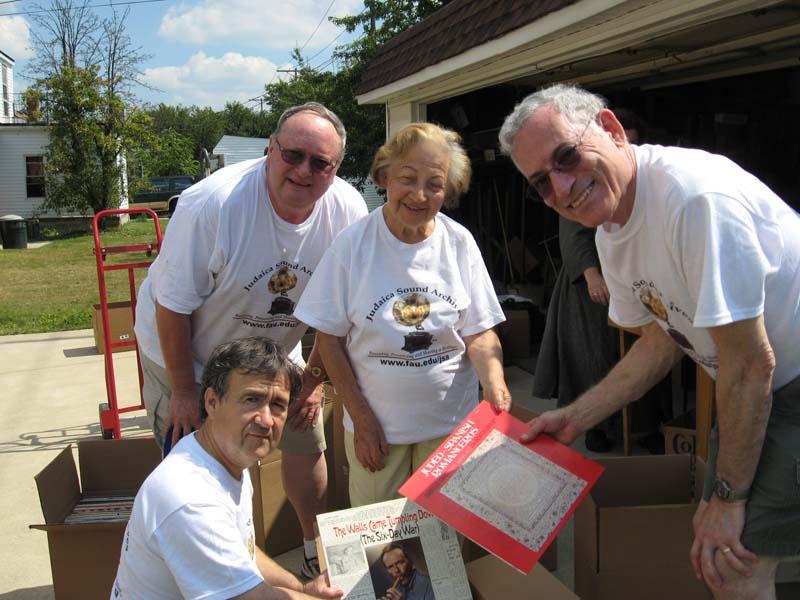
(Bottom) Ben Roth; standing from left: Bill King, Hinda Saul, Nathan Tinanoff
 About the RSA, Events & General Interest, Judaic Collection, Music Rescue, Preservation & Restoration, Vintage Collection
|
About the RSA, Events & General Interest, Judaic Collection, Music Rescue, Preservation & Restoration, Vintage Collection
|  FAU Libraries, Jack Saul, Jack Saul Collection, Judaica, Nathan Tinanoff, phonograph records
FAU Libraries, Jack Saul, Jack Saul Collection, Judaica, Nathan Tinanoff, phonograph records
On Rosh Hashanah it is written and on Yom Kippur it is sealed: how many will pass from the earth and how many will be created….But during the Days of Awe, Repentance, Prayer and Charity can avert a severe decree.
Some of Judaism’s most beautiful and compelling music has been inspired at this sacred time of year. The importance, emotion and solemnity of the music of the Holy Days represent the highest achievements of the cantorial art. The Judaica Sound Archives at Florida Atlantic University Libraries is proud of its outstanding collection of cantorial recordings. During the next few weeks the JSA will highlight some of the great cantors of the past and present singing the music of the High Holy Days.
 The incredible lyrical tenor voice of Cantor Leib Glantz evokes the feeling and intensity of the old “Ba’al T’filoh” of Eastern European Jewish communities. Through his voice and his compositions we can be transported through time to an era long gone, but not forgotten.
The incredible lyrical tenor voice of Cantor Leib Glantz evokes the feeling and intensity of the old “Ba’al T’filoh” of Eastern European Jewish communities. Through his voice and his compositions we can be transported through time to an era long gone, but not forgotten.
Born in Kiev (Ukraine) in 1898, Cantor Leib Glantz lived in the USA from 1926 to 1954 when he was able to fulfill his dream of moving to Israel. He died on January 27, 1964 in Tel Aviv. He was the last, and perhaps the greatest cantor of the “Golden Age of Chazanut.”
The quality of his musical education, his penetrating knowledge of the Hebrew language, and his deep philosophical religiosity, enabled him to create musical interpretations of the prayers that brought new light and meaning to every word. “The words he sang seemed destined to rise like angels into the heavens. To listen to him was like witnessing a man speaking to God! He had a voice that sang like no other voice. Many cantors have tried to imitate his singing, but few have felt they have succeeded.”
| Glantz combined his cantorial art with fervent and tireless Zionist activism. He edited a Zionist newspaper and was a leader in the Zionist movement in Eastern Europe, the United States, and finally, Israel.
Leib Glantz was a great scholar who explored the origins of Jewish music and firmly established the historical continuity of Jewish music from its beginning in the Holy Temples of Jerusalem to modern times. He also founded an Academy for Cantors in the Tel Aviv Institute for Jewish Liturgical Music.
|
 Click here to listen to this album |
 Events & General Interest, Judaic Collection, On-line music collections, Online Access, Performer Biographies, Performers, Recordings Pre-1950
|
Events & General Interest, Judaic Collection, On-line music collections, Online Access, Performer Biographies, Performers, Recordings Pre-1950
|  Cantor Leib Glantz, Cantorial music, High Holy Days, Holiday, Jewish Religious & Holiday Music, Rosh Hashanah
Cantor Leib Glantz, Cantorial music, High Holy Days, Holiday, Jewish Religious & Holiday Music, Rosh Hashanah








 The incredible lyrical tenor voice of
The incredible lyrical tenor voice of 